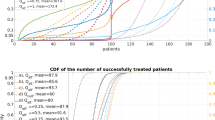Abstract
Group sequential tests have been effective tools in monitoring long term clinical trials. There have been several popular discrete sequential boundaries proposed for modeling interim analysis of clinical trials under the assumption of Brownian motion for the stochastic processes generated from test statistics. In this paper, we study the five sequential boundaries in Lan and DeMets (Biometrika 70:659–663, 1983) under the fractional Brownian motion. The fractional Brownian includes the classic Brownian motion as a special case. An example from a real data set is used to illustrate the applications of the boundaries.
Similar content being viewed by others
References
Bardina X, Jolis M (2006) Multiple fractional integral with Hurst parameter less than 1/2. Stoch Process Appl 116: 463–479
Beran J (1994) Statistics for ong-memory processes. Chapman and Hall, New York
D’Auria B, Samorodnitsky G (2005) Limit behavior of fluid queues and networks. Oper Res 53: 933–945
Davies RB, Harte DS (1987) Tests for Hurst effect. Biometrika 74: 95–101
Davis BR, Hardy RJ (1990) Upper bound for type I and type II error rates in conditional power calculation. Commun Stat Theory 19: 3571–3584
Davis BR, Hardy RJ (1994) Data monitoring in clinical trials: the case for stochastic curtailment. J Clin Epidemiol 47: 1033–1042
DeMets DL, Hardy R, Friedman LM, Lan KKG (1984) Statistical aspects of early termination in the beta-blocker heart attack trial. Control Clin Trials 5: 362–372
DeMets DL, Lan KKG (1994) Interim analysis: the alpha-spending function. Stat Med 13: 1341–1352
Fisher LD (1999) Carvedilol and the food and drug administration (FDA) approval process: the FDA paradigm and reflection on hypothesis testing. Control Clin Trials 20: 16–39
Gebber GL, Orer HS, Barman SM (2006) Fractal noises and motions in time series of presympathetic and sympathetic neural activities. J Neurophysiol 95: 1176–1184
Genz A (1992) Numerical computation of multivariate normal probabilities. J Comput Graph Stat 1: 141–150
Genz A (1993) Comparison of methods for the computation of multivariate normal probabilities. Comput Sci Stat 25: 400–405
Heyde CC (2002) On models of long-range dependence. J Appl Stat 39: 882–888
Hu YZ, Okendal B, Sulem A (2003) Optimal consumption portfolio in a Black-Scholes market driven by fractional Brownian motion. Infin Dimens Anal Quantum Probab Relat Top 6: 519–536
Hussein A, Carriere KC (2005) On group sequential procedures under variance heterogeneity. Stat Methods Med Res 14: 121–128
Jennison C, Turnbull BW (2006a) Adaptive and nonadaptive group sequential tests. Biometrika 93: 1–21
Jennison C, Turnbull BW (2006b) Efficient group sequential design when there are several effect sizes under consideration. Stat Med 25: 917–932
Lachin JM (2005) A review of methods for futility stopping based on conditional power. Stat Med 24: 2747–2764
Lai DJ (2004) Estimating the Hurst effect and its application in monitoring clinical trials. Comput Stat Data Anal 45: 549–562
Lai DJ, Davis BR, Hardy RJ (2000) Fractional Brownian motion and clinical trials. J Appl Stat 27: 103–108
Lan KKG, DeMets DL (1983) Discrete sequential boundaries for clinical trials. Biometrika 70: 659–663
Lan KKG, Wittes J (1988) The B-value: a tool for monitoring data. Biometrics 44: 579–585
Leon JA, Nualart D (2006) Clark-ocone formula for fractional Brownian motion with Hurst parameter less than 1/2. Stoch Anal Appl 24: 427–449
Mandelbrot BB, Van Ness JW (1968) Fractional Brownian motions, fractional noise and applications. SIAM Rev 10: 422–437
Mielniczuk J, Wojdyllo P (2007) Estimation of Hurst exponent revisited. Comput Stat Data Anal 51: 4510–4525
Moye LA (1999) End-point interpretation in clinical trials: The case for discipline. Control Clin Trials 20: 40–49
Novikov A, Frishling V, Kordzakhia N (1999) Approximations of boundary crossing probabilities for a Brownian motion. J Appl Probab 36: 1019–1030
O’Brien PC, Fleming TR (1979) Multiple testing procedure for clinical trials. Biometrics 35: 549–556
Pocock SJ (1977) Group sequential methods in design and analysis of clinical trials. Biometrika 64: 191–200
Reboussin DM, DeMets DL, Kim K, Lan KKG (2000) Computations for group sequential boundaries using the Lan-DeMets spending function method. Control Clin Trials 21: 190–207
Shih WJ (2006) Group sequential, sample size re-estimation and two-stage adaptive design in clinical trials: A comparison. Stat Med 25: 933–941
Siegmund D (1986) Boundary crossing probabilities and statistical applications. Ann Stat 14: 361–404
Wald A (1945) Sequential tests of statistical hypotheses. Ann Math Stat 16: 117–186
Author information
Authors and Affiliations
Corresponding author
Rights and permissions
About this article
Cite this article
Lai, D. Group sequential tests under fractional Brownian motion in monitoring clinical trials. Stat Methods Appl 19, 277–286 (2010). https://doi.org/10.1007/s10260-010-0138-8
Accepted:
Published:
Issue Date:
DOI: https://doi.org/10.1007/s10260-010-0138-8




